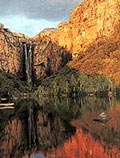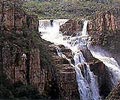 Listed as a UNESCO World Heritage area, Kakadu National Park covers 19,804 sq. km with diverse scenic wonders encompassing red escarpment cliffs, waterfalls, billabongs, long twisting rivers, stony plateaus, and huge galleries of Aboriginal rock art. It is also home to a quarter of all Australian freshwater fish, over 1,000 plant species, 300 types of birds, 75 species of reptiles, many mammals, and countless insects. Listed as a UNESCO World Heritage area, Kakadu National Park covers 19,804 sq. km with diverse scenic wonders encompassing red escarpment cliffs, waterfalls, billabongs, long twisting rivers, stony plateaus, and huge galleries of Aboriginal rock art. It is also home to a quarter of all Australian freshwater fish, over 1,000 plant species, 300 types of birds, 75 species of reptiles, many mammals, and countless insects.
The name "Kakadu" comes from "Gagudju", which is the main Aboriginal language used in the area at the start of the 20th Century. For the past 50,000 years, Aboriginal people have continuously lived in the area defined by the National Park. Their shelters, stone tools, grindstones, and ochre for ceremonial painting found are preserved.
Yellow Water
 For a start, take a cruise on the Yellow Water, which will give a good introduction to Kakadu and its natural glories. Lotus lilies, crocodiles, kookaburras, magpie geese, jabirus, and other bird species can be seen. For a start, take a cruise on the Yellow Water, which will give a good introduction to Kakadu and its natural glories. Lotus lilies, crocodiles, kookaburras, magpie geese, jabirus, and other bird species can be seen.
Aboriginal Rock Art
 For Aboriginal rock art, the area Nourlangie and Ubirr Rocks have some paintings dating more than 20,000 years old. It was also found that the earliest paintings at Ubirr Rocks are up to 23,000 years old, which would make them the oldest art works known anywhere in the world. At Nourlangie Rock, the famous Namarragon, the Lightning Man, can be found. This painting is centuries old but was repainted until 1900. For Aboriginal rock art, the area Nourlangie and Ubirr Rocks have some paintings dating more than 20,000 years old. It was also found that the earliest paintings at Ubirr Rocks are up to 23,000 years old, which would make them the oldest art works known anywhere in the world. At Nourlangie Rock, the famous Namarragon, the Lightning Man, can be found. This painting is centuries old but was repainted until 1900.
Falls
 Experience the spectacular Twin Falls and Jim Jim Falls thundering over the edge of a high plateau into deep rock pools and billabongs. The southern and drier end of Kakadu holds some magical places such as the Gunlom Waterhole, which is home to the rainbow serpent, Borlung, in Aboriginal legend. Experience the spectacular Twin Falls and Jim Jim Falls thundering over the edge of a high plateau into deep rock pools and billabongs. The southern and drier end of Kakadu holds some magical places such as the Gunlom Waterhole, which is home to the rainbow serpent, Borlung, in Aboriginal legend.
Top of Page |
